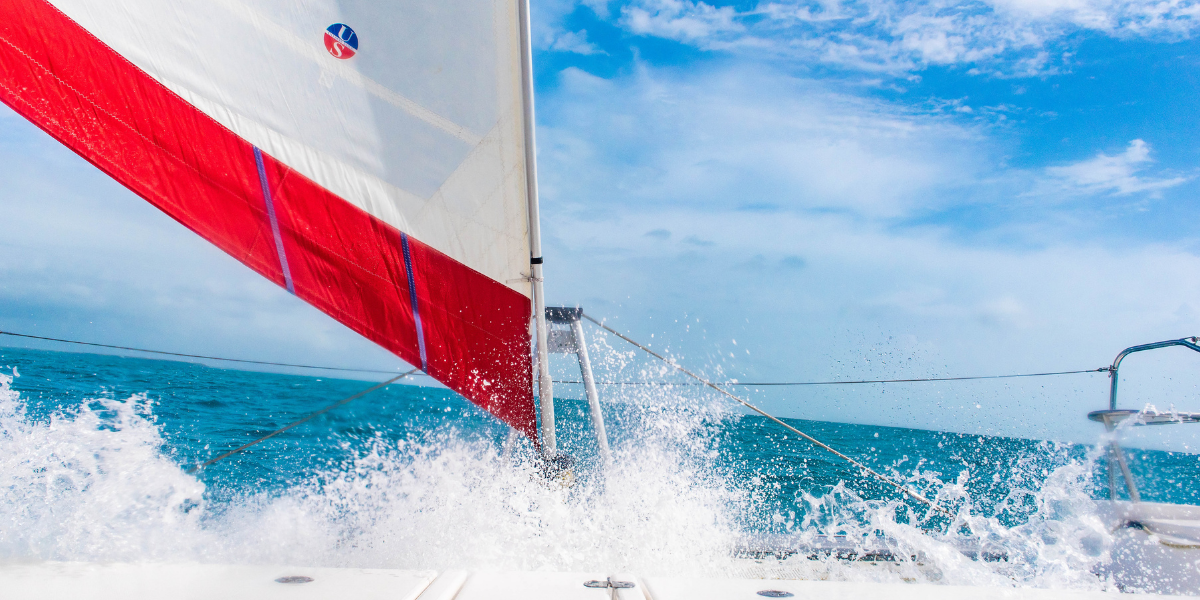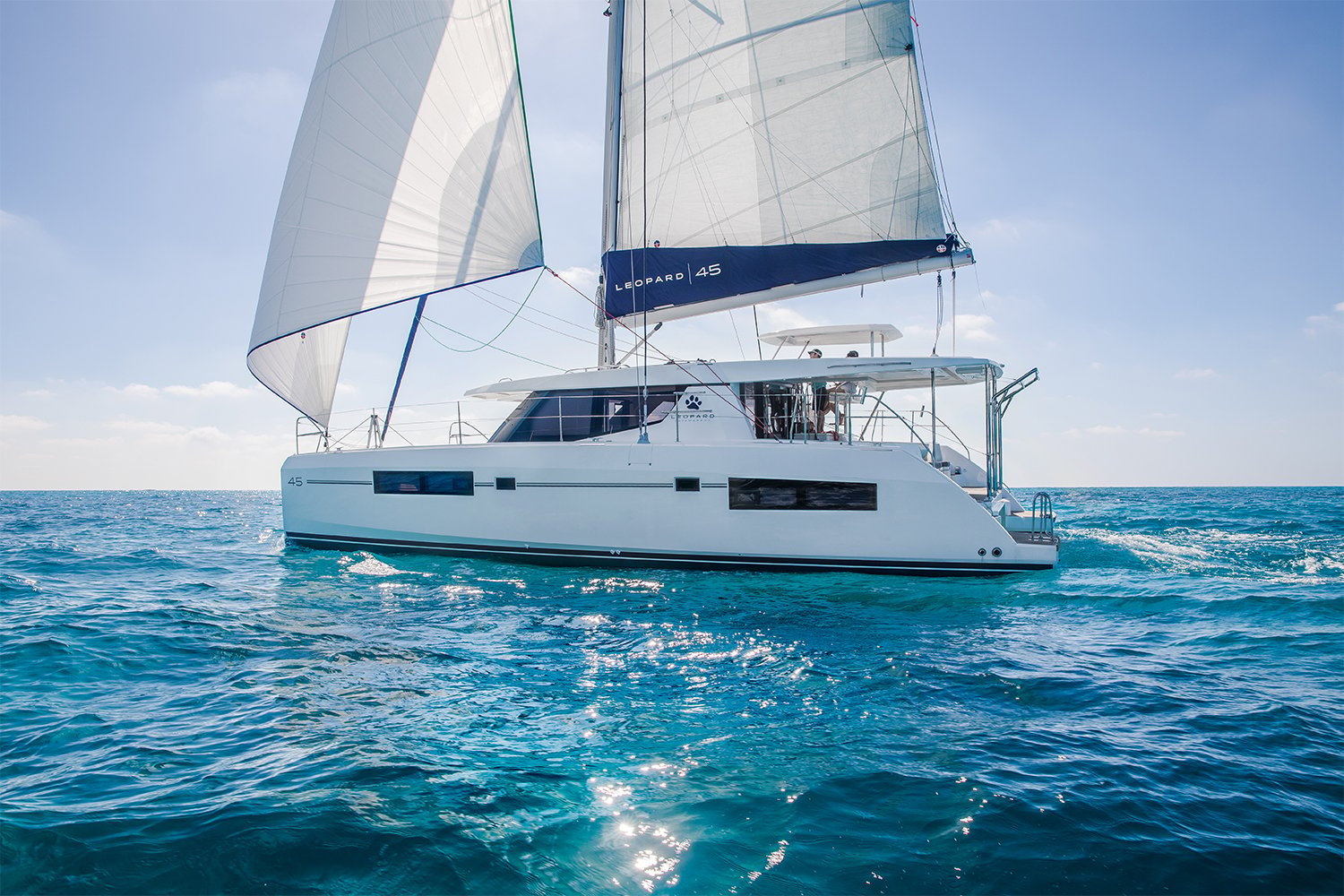Expect the best, plan for the worst — and prepare to be surprised. That venerable bit of wisdom sums up the perfect mindset for outfitting your Catamaran with safety equipment.
Investing in the right emergency gear — which often means going above and beyond the minimum regulatory requirements — can enhance your sailing experience by giving you the peace of mind that comes with preparedness.
Here are some safety systems that every catamaran owner should consider adding to their vessel.
Upgraded PFDs
The best life jacket is the one you will wear, right? That’s why Jim O’Connor, owner of Life Rafts and Safety Equipment Inc, recommends inflatable PFDs over the bulkier foam life jackets.
“There are several inflatable jackets that are almost like wearing suspenders,” says O’Connor. “You can wear them all day through all sorts of activities, and they are barely noticeable. Some inflate when you hit the water; others require the wearer to pull a pin. I strongly recommend upgraded life jackets for anyone doing open ocean cruising.”
Inflatable life jackets cost anywhere from $100 to $300, depending on the features.
Be sure to follow the PFD manufacturer’s inspection and maintenance schedule recommendations. These will likely start with making sure that any included service indicator light is green, not red. Regular checks for rips or tears and bladder leaks are also standard practice. Auto-inflating PFDs should be checked regularly to ensure the auto components are functional and armed. Check CO2 cylinders should be firmly secured and free of rust or corrosion.
AIS Man Overboard Device (MOD)
These electronic beacons, which are attached to PFDs, notify your Leopard’s VHF radio and nearby boaters when someone goes overboard. About one minute after the wearer hits the water, the MOD’s AIS unit sends a signal that sets off a loud beeping on your VHF radio and pinpoints the person’s location on the Multifunction Display (MFD).
“Anyone working or doing watch at night should be wearing a Man Overboard Device,” says O’Connor.
AIS MODs can be purchased for $200 and $300. Ideally, every PFD on your boat should be equipped with a MOD.
MODs should be checked out on a regular basis, and always before any extended cruise. Make sure the device is properly installed on the PFD, the battery is in-date, and the MOD is armed. You might also consider doing an on-dock test of the AIS signal. Start this process by announcing your intention to test over the VHF radio five or ten minutes before you activate the MOD. Include your MMSI number in this alert. When you activate the MOD, it should show up on your MFD and the plotters on other boats in the marina.
Man Overboard Retrieval System
Once you’ve located someone in the water, you need to secure them until you can get them back on board. MOB retrieval systems can help with both tasks. These compact rail-mounted systems release a sling or small raft onto the water with a line running back to the boat. The man overboard gets into the sling and is pulled back to the craft, where they can be winched aboard. While a rail-mounted horseshoe buoy can perform a similar duty, some MOB retrieval systems reduce the threat of hypothermia by getting the person out of the water and onto a raft. Others include features that make it easier to hoist the rescued person on board or recover an unconscious person. Retrieval systems also take up less rail space than a horseshoe buoy.
O’Conner recommends installing MOB retrieval systems on both the port and starboard rails. “That way,” he says, “You won’t lose a lot of time getting the device deployed on the opposite side.”
MOB retrieval systems cost $1,000 to $1,200.
MOBs should be inspected at least annually. Make sure the horseshoe and the pylon inflate and hold air. The water-activated flashing strobe unit should also be checked out. The entire strobe assembly needs to be replaced every five years. The MOB’s CO2 cylinders and all lift points should also be inspected for corrosion.
Fire Suppression Tool (FST)
These suitcase-sized units disperse an aerosol that immediately drops the heat generated by a fire and quickly extinguishes the flames. When a fire breaks out, simply pull the FST’s pin and toss the device into the burning space.
Life Raft
An inflatable life raft is an insurance policy against the unthinkable. Vacuum-packed into a small canister or valise, the raft takes up minimal storage space and can be deployed easily. Some rafts open upon hitting the water; others are activated by a tug on their painter.
Depending on size and features, rafts run anywhere from $3,000 to $6,000.
Most leisure life rafts require service every three years while commercial life rafts must be inspected annually. The goal of this maintenance is to guarantee the raft will inflate and hold air. That means pressure testing the raft and repacking it. Because the life raft is so critical to your safety, the inspection process should be entrusted to professionals.
EPIRB
Once you’re safely in that life raft, you need to activate your Emergency Position Indicating Radio Beacon or EPIRB, which uses a satellite signal to alert the closest search and rescue services and nearby boaters.
“This is your first line of defense in an emergency,” says O’Connor.
EPIRB devices cost anywhere from $300 to $600. The device must be registered with the proper government authorities. U.S. boat owners, for example, register their EPIRBs with NOAA while Canadian boaters register with the Canadian Beacon Register.
The EPIRB is so important to boating safety that experts recommend it be inspected monthly.
Every part of the device should be checked and tested. Follow NOAA’s detailed monthly EPIRB inspection process and you will sleep better at sea.
Total Investment
O’Connor says investing in the full range of safety gear should cost a bluewater boat owner somewhere between $7,000 and $10,000. And, he says, don’t skip or skimp in maintenance.
“The marine environment is very harsh and unpredictable,” says O’Connor. “We can open a seven-year-old life raft, and it might be perfect. But then we’ll see a one-year-old raft that’s trashed. You need a professional to handle this work. You don’t want to be packing your own parachute. Why take a risk with your safety?”
Why, indeed.


